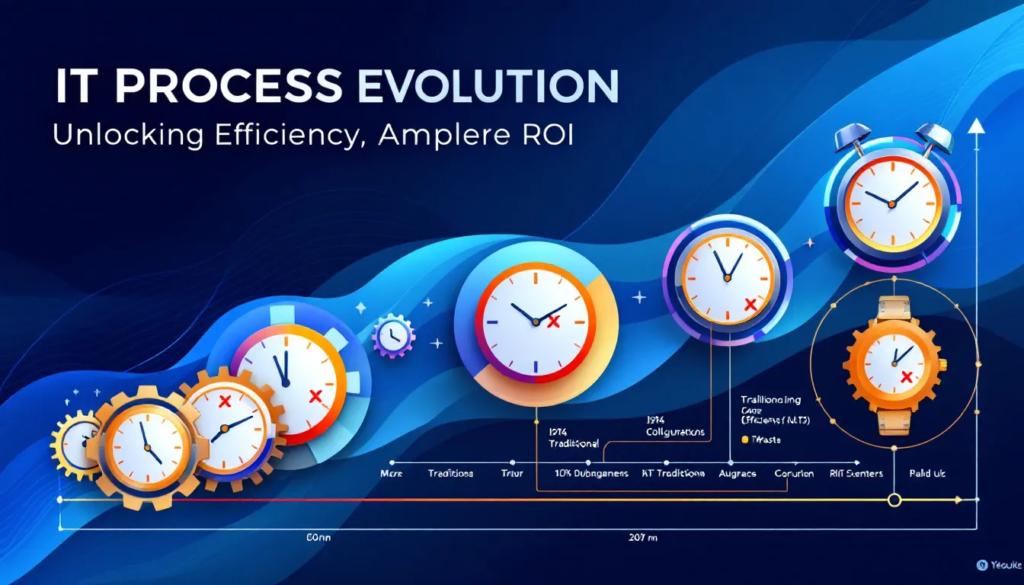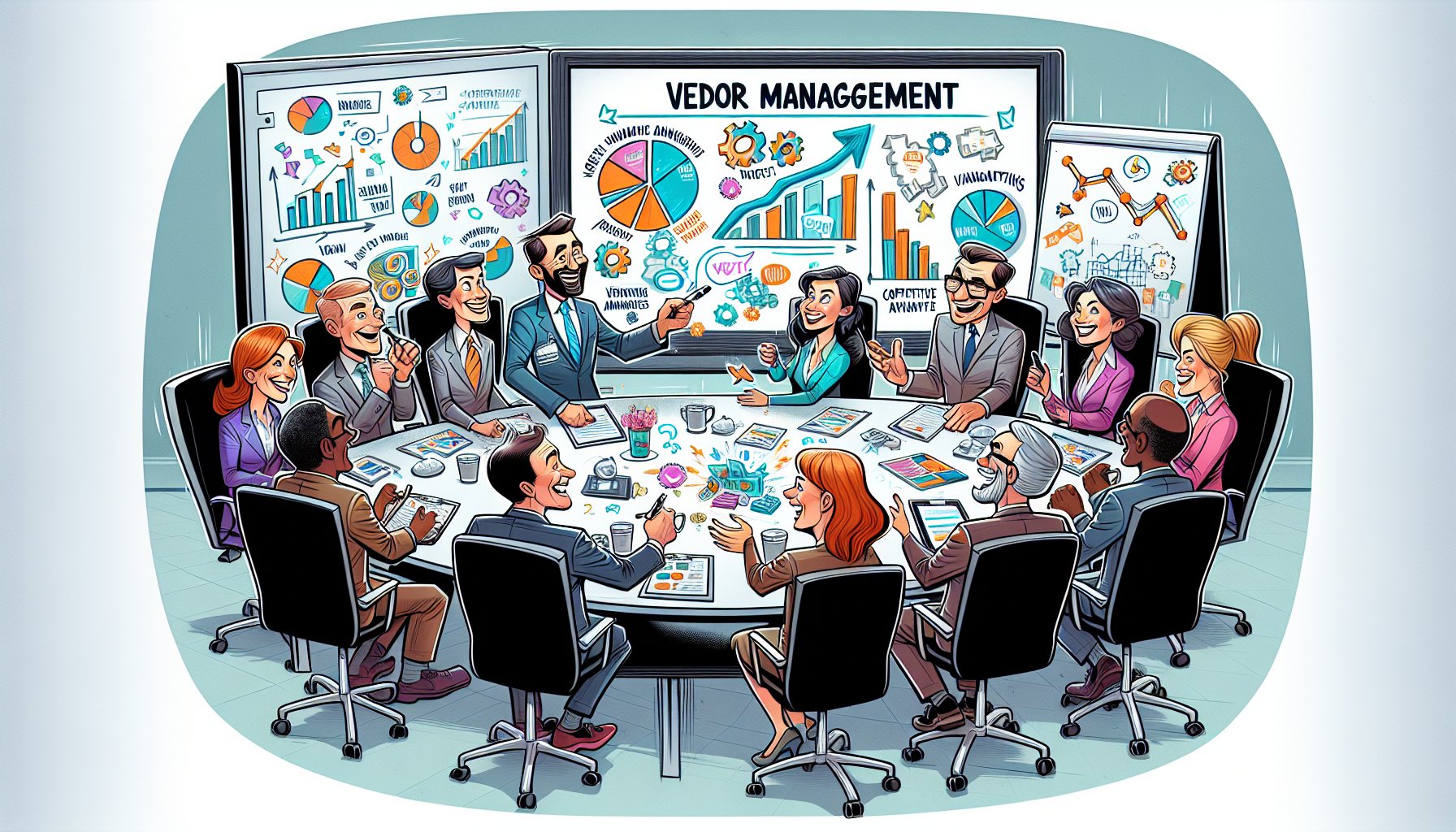Are you wondering whether traditional IT or streamlined IT processes deliver more ROI? Traditional IT offers stability through meticulous planning, whereas streamlined IT leverages agility and automation for efficiency. This article dissects ‘traditional IT vs streamlined IT processes which delivered more ROI,’ examining their costs, productivity, and overall benefits. Discover which IT approach can maximize your financial performance.
Key Takeaways
Traditional IT processes are characterized by rigidity and extensive upfront costs due to their linear, waterfall methodology, which can stifle innovation and slow decision-making.
Streamlined IT processes promote agility and efficiency through automation and real-time insights, resulting in lower operational costs, enhanced productivity, and improved customer satisfaction.
The transition from traditional to streamlined IT requires overcoming employee resistance and ensuring regulatory compliance, while leveraging advanced technologies to optimize processes and deliver better ROI.
Defining Traditional IT Processes

Traditional IT processes typically adhere to a linear and sequential software development model known as the Waterfall methodology. This approach emphasizes extensive planning and documentation, ensuring that every step is well-recorded and defined. Each phase of the project must be completed before moving on to the next, creating a rigid structure that can sometimes hinder flexibility and innovation. This rigidity often results in higher upfront costs due to the need for comprehensive planning and infrastructure investments.
Moreover, traditional IT structures often consist of siloed departments, making cross-departmental communication challenging. This siloed approach can lead to inefficiencies and delays in decision-making, as multiple layers of approval are typically required.
While this method focuses on stability and minimizing risk, it can stifle innovation and limit the organization’s ability to quickly adapt to changing market demands.
Defining Streamlined IT Processes

Streamlined IT processes, on the other hand, emphasize agility and flexibility, enabling organizations to adapt quickly to changing business needs. These processes often incorporate advanced technologies, such as automation and real-time insights, to optimize workflows and enhance productivity. By automating repetitive tasks, businesses can reduce manual interventions, minimize human error, and allow teams to focus on more strategic initiatives.
Adopting an agile approach, streamlined IT processes foster continuous improvement through rapid iteration and feedback. DevOps practices are often integrated, supporting faster development cycles, quicker deployment of new features, and improved customer satisfaction. This approach not only reduces operational costs but also drives sustainable growth by empowering employees and encouraging innovation.
Key Differences Between Traditional and Streamlined IT
The key differences between traditional and streamlined IT processes lie in their approach to structure, decision-making, and responsiveness. Traditional IT relies on rigid structures and processes, where each phase must be completed before the next begins, leading to potential delays and inefficiencies. In contrast, streamlined IT emphasizes flexibility and adaptability, allowing for quicker adjustments to meet market demands.
Decision-making in traditional IT often involves multiple layers of approval, which can create bureaucratic hurdles and slow down project completion. Streamlined IT, however, adopts a more decentralized approach, enabling faster decision-making and reducing bottlenecks. This decentralized approach aligns with the principles of business agility, allowing organizations to respond more effectively to market changes and customer needs.
Furthermore, the focus on automation and integration in streamlined IT processes reduces manual tasks and enhances overall efficiency. Traditional IT, with its longer planning cycles and extensive documentation, can lead to increased operational costs and delays in project launches. By streamlining operations, businesses can achieve better outcomes, improve collaboration, and drive continuous improvement.
Impact on Operational Costs

Operational costs are a critical factor in evaluating the ROI of IT processes. Traditional IT often incurs significant initial expenses related to setup and infrastructure, leading to higher upfront costs. In contrast, streamlined IT processes aim to minimize expenses through efficiency and automation, resulting in lower operational costs over time and improved operational processes.
Understanding these cost dynamics is essential for businesses to make informed decisions about their IT investments.
Traditional IT: Higher Upfront Costs
Traditional IT setups typically require substantial investments in extensive hardware and software, contributing to higher upfront costs. These investments are necessary to establish the infrastructure needed for long-term stability and performance. Additionally, bureaucratic processes within traditional IT can lead to resource allocation issues, affecting overall productivity and increasing operational costs.
The focus on extensive planning and documentation further adds to the initial expenses. While these measures aim to ensure stability and minimize risk, they can also create inefficiencies and delays, impacting the overall return on investment. As a result, businesses may face higher costs and longer timelines before realizing the benefits of their IT investments.
Streamlined IT: Lower Operational Costs
Streamlined IT processes facilitate quicker implementation and scalability, reducing overall costs. By adopting automation and cloud services, businesses can significantly lower their operational expenses compared to maintaining on-premise systems. This approach not only reduces labor costs but also minimizes human error, enhancing operational efficiency.
Companies that have embraced streamlined IT have achieved notable outcomes, such as a 40% boost in operational efficiency and a 30% drop in operational costs. The ability to quickly scale and adapt to changing business needs further contributes to cost savings and improved ROI.
By minimizing manual interventions and focusing on continuous improvement, streamlined IT processes enable businesses to allocate resources more effectively and drive sustainable growth.
Enhancing Productivity and Innovation

Productivity and innovation are key drivers of business success, and the approach to IT processes can significantly impact these areas. Traditional IT often faces bureaucratic hurdles that can stifle innovation and limit employee productivity. In contrast, streamlined IT fosters a culture of continuous improvement, enabling organizations to enhance their operations and adaptability.
Understanding how each approach affects productivity and innovation is crucial for businesses to stay competitive in the evolving business landscape.
Traditional IT: Bureaucratic Hurdles
Traditional IT processes focus on stability and minimizing risk, which can hinder innovation. Underinvestment in digital tools further reduces productivity gains, as employees lack the necessary resources to perform their tasks efficiently. Communication and collaboration bottlenecks also arise from the lengthy decision-making processes, delaying project timelines and affecting overall productivity.
Moreover, traditional fulfillment processes in IT are often resource-intensive and prone to errors, lacking the flexibility and responsiveness needed to adapt to changing business needs in the supply chain management. These bureaucratic hurdles can create significant challenges for organizations, limiting their ability to innovate and drive sustainable growth.
Streamlined IT: Fostering Continuous Improvement
Streamlined IT processes emphasize continuous improvement by involving employees in the process of change and gathering their feedback to identify inefficiencies. Assessing current processes is essential for optimizing workflows and reducing redundant steps, excessive paperwork, and delays. Data analysis plays a key role in identifying patterns that indicate bottlenecks and areas for improvement.
Automation of repetitive tasks is a cornerstone of streamlined IT, allowing companies to increase productivity and focus on strategic initiatives. Tools like Zapier and IFTTT can effectively automate routine tasks, minimizing manual interventions and enhancing operational efficiency. Investing in comprehensive training programs and promoting open communication further reduces resistance to new IT processes and boosts employee productivity.
Advanced technologies such as AI and machine learning help reduce costs, improve customer satisfaction, and drive sustainable growth through technology solutions, thereby enhancing overall productivity. By fostering a culture of continuous improvement, streamlined IT processes empower employees and encourage innovation, leading to better outcomes for the organization.
Customer Satisfaction and Service Efficiency
Customer satisfaction and service efficiency are critical metrics for evaluating the success of IT processes. Traditional IT processes can lead to slower response times and lower customer satisfaction due to lengthy approval and deployment cycles. In contrast, streamlined IT processes enhance customer service efficiency, leading to higher customer satisfaction through faster bug fixes and feature improvements.
Understanding how each approach impacts customer service is essential for businesses to meet customer expectations and drive loyalty.
Traditional IT: Slower Response Times
Approval processes in traditional IT are typically lengthy, which can slow down project initiation and progress. These lengthy approval cycles significantly delay response times for customer inquiries, affecting customer satisfaction. Additionally, Service Level Agreements (SLAs) in traditional IT may not always be met due to inefficient processes, further impacting service efficiency.
The time-consuming nature of traditional IT processes can hinder the organization’s ability to quickly respond to customer needs and market changes. This delay in response times can lead to customer dissatisfaction and lost business opportunities, highlighting the importance of streamlining operations to improve service efficiency.
Streamlined IT: Improved Customer Service
Streamlined IT processes leverage automation within IT service delivery to reduce response times and enhance overall customer satisfaction. A centralized service desk facilitates quicker resolution of customer issues, improving service efficiency and customer experience. Implementing a service catalog helps customers understand available services and their details, fostering better communication and transparency.
Innovative training programs, such as Target’s on-the-job training, have demonstrated the effectiveness of streamlined IT processes by significantly increasing customer satisfaction scores. Similarly, Tesla’s approach to redefining car purchasing and ownership through innovative online sales and over-the-air software updates has enhanced customer engagement and satisfaction.
These examples highlight how streamlined IT processes can lead to improve customer service and better business outcomes.
Measuring ROI in IT Processes
Measuring ROI in IT processes is crucial for understanding the effectiveness of IT investments and optimizing operational performance. Traditional and streamlined IT approaches use different metrics to evaluate their success. The focus is on streamlining operations and continuously measuring performance to identify areas for improvement and ensure a higher return on investment.
Understanding these metrics is essential for businesses to make informed decisions about their IT strategies.
Traditional IT Metrics
Traditional IT metrics are essential tools for measuring performance, cost reductions, and stability. Common metrics focus on long-term stability, response times, and cost per order, providing organizations with a clear understanding of their IT investments’ effectiveness. These metrics are crucial for long-term planning and ensuring that the IT infrastructure supports the organization’s goals.
However, traditional IT metrics may not fully capture the dynamic nature of modern business environments. The focus on stability and minimizing risk can sometimes overshadow the need for agility and rapid response to market changes. As a result, businesses must balance these metrics with the need for flexibility and continuous improvement.
Streamlined IT Metrics
Streamlined IT metrics are designed to enhance performance and adaptability by focusing on specific indicators such as the frequency of deployments and the speed of recovery from failures. By comparing key performance indicators (KPIs) before and after implementing streamlined processes, businesses can effectively measure ROI improvement. Metrics such as deployment frequency, recovery times, and change failure rates provide valuable insights into the efficiency and effectiveness of streamlined IT.
These metrics allow organizations to continuously measure performance and identify areas for further optimization. By leveraging these insights, businesses can ensure that their IT investments are delivering the desired outcomes, enhancing overall productivity and adaptability. Streamlined IT metrics thus play a crucial role in driving continuous improvement and ensuring a higher return on investment.
Case Studies and Real-World Examples
Real-world examples provide valuable insights into how different companies have leveraged either traditional or streamlined IT processes to enhance their returns on investment. Both approaches can lead to significant improvements in organizational performance, depending on the specific needs and goals of the business.
By examining these case studies, businesses can better understand the practical applications and benefits of each IT strategy.
Success Stories from Traditional IT
Accenture’s investment in training led to a 20% rise in employee performance and a 30% increase in client satisfaction, showcasing the benefits of traditional IT practices. Similarly, Marriott’s College Graduate Program improved operational efficiency by 20% and enhanced employee engagement, demonstrating success in traditional IT methods. These examples highlight the stability and reliability that traditional IT processes can provide, contributing to significant ROI.
Organizations that have successfully implemented traditional IT processes often report enhanced system reliability and stability, which are crucial for long-term success. By focusing on extensive planning and documentation, these businesses ensure that their IT infrastructure supports their operational needs and goals. This approach, while sometimes costly upfront, can lead to substantial returns over time.
Success Stories from Streamlined IT
Domino’s Pizza revitalized its business through technology integration, allowing customers to order via various digital channels, resulting in a substantial stock price increase. Michelin utilized AI technology to streamline operations and improve client experience, enhancing decision-making and reducing resource use. Walmart’s investment in digital transformation optimized supply chains and inventory management, leading to reduced costs and improved efficiency.
Nike shifted from wholesale to direct-to-consumer sales, increasing e-commerce revenue and fostering a community around their brand through dedicated apps. Macy’s mentorship program paired experienced employees with new hires, resulting in a 15% decrease in turnover, reflecting improvements from streamlined IT methods.
These examples demonstrate how streamlined IT processes can lead to significant improvements in business agility, customer satisfaction, and overall ROI. The success stories from streamlined IT highlight the importance of flexibility, automation, and continuous improvement. By leveraging advanced technologies and focusing on rapid iteration, these companies have achieved remarkable outcomes, driving sustainable growth and enhancing their competitive edge.
Challenges and Considerations
Transitioning from traditional to streamlined IT processes presents several challenges and considerations. Significant resistance from employees, stemming from fear of the unknown and disruptions to established workflows, is a common obstacle. Additionally, both traditional and streamlined IT processes must prioritize regulatory compliance to ensure they meet legal and industry standards.
Addressing these challenges is crucial for a successful transition and optimizing IT processes.
Overcoming Resistance to Change
Cultural resistance often hinders innovation, with a significant portion of transformation initiatives failing due to employee reluctance. Employees may resist change due to fear of the unknown, potential job loss, and lack of trust in management. Overcoming resistance requires businesses to implement extensive training programs to equip employees with the necessary skills for new IT processes. Clear communication and involving employees in the change process are also essential to build trust and reduce apprehension.
Empowering employees through training and open communication fosters a culture of continuous improvement and business agility. By addressing employee concerns and providing adequate support, organizations can reduce resistance to new IT processes and encourage innovation. This approach not only enhances productivity but also ensures that the transition to streamlined IT is smooth and effective.
Ensuring Regulatory Compliance
Both traditional and streamlined IT systems must implement specific strategies to maintain adherence to regulatory requirements. Traditional IT often relies on comprehensive documentation and manual audits to ensure compliance, while streamlined IT integrates automated monitoring tools to achieve the same goal. These automated tools provide real-time insights and ensure that the organization meets evolving regulatory standards.
Implementing regulatory compliance strategies is crucial for avoiding legal pitfalls and ensuring business operations run smoothly. By accurately assessing and improving processes, businesses can maintain compliance and mitigate risks associated with IT transitions. This proactive approach not only safeguards the organization but also enhances operational efficiency and overall productivity.
Future Trends in IT Process Optimization

The future of IT process optimization lies in digital transformation and the adoption of innovative technologies such as AI and machine learning. These technologies enable businesses to enhance productivity, automate repetitive tasks, and drive sustainable growth. Continuous improvement in IT relies on regularly evaluating and optimizing automation tools to further enhance productivity and operational efficiency.
Effective IT service delivery is essential for meeting customer expectations and achieving business growth. By implementing agile methodologies and focusing on continuous improvement, organizations can stay ahead of market demands and emerging opportunities.
The integration of advanced technologies and strategic initiatives will continue to shape the future of IT process optimization, ensuring better outcomes and a higher return on technology investments.
Summary
In conclusion, both traditional and streamlined IT processes have their unique strengths and challenges. Traditional IT processes offer stability and reliability but often come with higher upfront costs and bureaucratic hurdles. On the other hand, streamlined IT processes emphasize agility, automation, and continuous improvement, leading to lower operational costs, enhanced productivity, and improved customer satisfaction. By understanding these differences and leveraging the appropriate strategies, businesses can optimize their IT investments and drive sustainable growth. The future of IT lies in embracing digital transformation and innovative technologies, ensuring that organizations remain competitive and achieve better outcomes.
Frequently Asked Questions
What are the main differences between traditional and streamlined IT processes?
The main differences between traditional and streamlined IT processes lie in their focus and efficiency. Traditional processes prioritize stability and extensive planning, while streamlined processes emphasize agility and automation, leading to improved productivity and lower costs.
How do streamlined IT processes reduce operational costs?
Streamlined IT processes effectively reduce operational costs by automating tasks, speeding up implementation, and utilizing cloud services, which in turn lowers labor costs and boosts operational efficiency.
What are some success stories of companies using streamlined IT processes?
Several companies have successfully utilized streamlined IT processes, including Domino’s Pizza, which enhanced its business via digital channels, and Michelin, which implemented AI to improve operations. Walmart also exemplifies success by optimizing its supply chains and inventory management through digital transformation.
How can businesses overcome resistance to change when transitioning to streamlined IT processes?
To overcome resistance to change in transitioning to streamlined IT processes, businesses should implement extensive training programs, ensure clear communication, involve employees in the change process, and address their concerns. This comprehensive approach fosters trust and minimizes resistance.
What future trends should businesses consider in IT process optimization?
Businesses should prioritize digital transformation, the adoption of AI and machine learning, continuous improvement, and agile methodologies to enhance productivity and automate tasks for sustainable growth. Embracing these trends will be crucial for future success.





